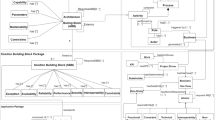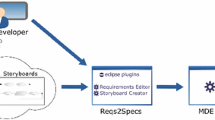Abstract
Software engineering’s lifecycle models have proven to be very important for traditional software development. However, can these models be applied to the development of Web-based applications as well? In recent years, Web-based applications have become more and more complicated and a lot of efforts have been placed on introducing new technologies such as J2EE, PhP, and.NET, etc., which have been universally accepted as the development technologies for Web-based applications. However, there is no universally accepted process model for the development of Web-based applications. Moreover, shaping the process model for small medium-sized enterprises (SMEs), which have limited resources, has been relatively neglected. Based on our previous work, this paper presents an expanded lifecycle process model for the development of Web-based applications in SMEs. It consists of three sets of processes, i.e., requirement processes, development processes, and evolution processes. Particularly, the post-delivery evolution processes are important to SMEs to develop and maintain quality web applications with limited resources and time.
Similar content being viewed by others
Explore related subjects
Discover the latest articles, news and stories from top researchers in related subjects.References
D. Lowe, W. Hall. Hypermedia & The Web: An Engineering Approach, New York, NY, USA: John Wiley & Sons, 1999.
I. Sommerville. Software Engineering, 6th Edition, Addison-Wesley, 2000.
M. Epner. Poor Project Management Number-one Problem of Outsourced E-projects, Research Briefs, Cutter Consortium, November 7, 2000.
R. H. Zakon. Hobbes’ Internet Timeline. [Online], Available: www.zakon.org/robert/internet/timeline/Count_www-log.gif, March, 2009.
S. Ceri, P. Fraternali, A. Bongio, M. Brambilla, S. Comai, M. Matera. Designing Data-intensive Web Applications, Morgan Kaufmann Publishers, 2003.
J. Conallen. Building Web Applications with UML, Harlow, UK: Addison-Wesley Longman, 1999.
H. W. Gellersen, M. Gaedke. Object oriented web application development. IEEE Internet Computing, vol. 3, no. 1, pp. 60–68, 1999.
A. Knapp, N. Koch, G. Zhang. Modeling the structure of web applications with argouwe. In Proceedings of the 4th International Conference on Web Engineering, Lecture Notes in Computer Science, Spinger, vol. 3140, pp. 771–772, 2004.
A. Ginige, S. Murugesan. Web engineering: An introduction. IEEE Multimedia, vol. 8, no. 1, pp. 14–18, 2001.
Y. Deshpande, S. Hansen. Web engineering: Creating a discipline among disciplines. IEEE Multimedia, vol.8, no.2 pp. 82–87, 2002.
C. Canali, M. Colajanni, R. Lancellotti. Resource management strategies for mobile web-based services. In Proceedings of IEEE International Conference on Wireless and Mobile Computing, Networking & Communication, pp. 172–177, 2008.
Z. Wei, M. Kang, W. Zhou. A semantic web-based enterprise information integration platform for mobile commerce. In Proceedings of International Conference on Management of e-Commerce and e-Government, IEEE, pp. 57–60, 2008.
S. Casteleyn, P. Plessers, O. D. Troyer. Modelling and tools: Generating semantic annotations during the web design process. In Proceedings of the 6th International Conference on Web Engineering, ACM, pp. 91–92, 2006
Y. Deshpande, S. Murugesan, A. Ginige, S. Hansen, D. Schwabe, M. Gaedke, B. White. Web engineering. Journal of Web Engineering, vol. 1, no. 1, pp. 3–17, 2002.
EU Commission Recommendation 96/280/EC, [Online], Available: www.eur-lex.europa.eu, March, 2009.
D. Berry. Academic Legitimacy of the Software Engineering Discipline, SEI Technical Report CMU/SEI-92-TR-34, Camegie Mellon University, USA, 1992.
N. Zelnick. Nifty technology and nonconformance: The Web in crisis. Computer, vol. 31, no. 10, pp. 115–116 and 119, 1998.
W. W. Gibbs. Software’s chronical crisis. Scientific American, vol. 271, no. 3, pp. 72–81, 1994.
R. S. Pressman. Software Engineering — A Practitioner’s Approach, 5th Edition, McGraw-Hill, 2003.
R. S. Pressman. Can internet-based applications be engineered? IEEE Software, vol. 15, no. 5, pp. 104–109, 1998.
IEEE, IEEE Standard Glossary of Software Engineering Terminology, 1990.
B. Boehm. A spiral model of software development and enhancement. Computer, vol. 21, no. 5, pp. 61–72, 1988.
D. Phillips. People, process, and product. American Programmer, vol. 8, no. 1, pp. 15–20, 1995.
K. Beck. Extreme Programming Explained: Embrace Change, Reading, Massachusetts, USA: Addison-Wesley, 2000.
I. Sommerville. Software Engineering, 7th Edition, Addison Wesley, 2004.
J. Á del Brío, B. Junquera. A review of the literature on environmental innovation management in SMEs: Implications for public policies, Technovation, vol. 23, no. 12, pp. 939–948, 2003.
W. Huang, R. Li, C. Maple, H. J. Yang, D. Foskett, V. Cleaver. Web applications development lifecycle for small and medium-sized enterprises (SMEs). In Proceedings of the 8th International Conference on Quality Software, Oxford, UK, pp. 247–252, 2008.
J. Z. Li, Z. P. Zhang, B. Qiao, H. J. Yang. A component mining approach to incubate grid services in object-oriented legacy systems. International Journal of Automation and Computing, vol. 3, no. 1, pp. 47–55, 2006.
Z. Zhang, D. D. Zhou, H. J. Yang, S. C. Zhong. A service composition approach based on sequence mining for migrating e-learning legacy system to SOA. International Journal of Automation and Computing. (to be published)
Author information
Authors and Affiliations
Corresponding author
Additional information
Wei Huang received the B. Sc. and M. Sc. degrees from South China University of Technology, PRC, and the Ph. D. degree at Loughborough University, UK.
He worked as a research fellow at the University of Nottingham for three years before he joined the University of Bedfordshire, UK in 2004. He is currently a senior lecturer in the Department of Computer Science and Technology at the University of Bedfordshire. He is also a member of the British Computer Society (MBCS) and a fellow of the Higher Education Academy in the UK.
His research interests include planning and scheduling, optimisation techniques, software, and web engineering.
Carsten Maple received the Ph.D. degree at the University of Leicester, UK, and joined the University of Bedfordshire, UK in March 1998 as a lecturer. He is then made senior lecturer in September 1998 and was promoted to professor of applicable computing in 2004. He became head of the Centre for Research in Distributed Technologies in June 2003 and he became head of the Department of Computer Science and Technology in September 2004. He serves as an editor and/or co-editor in a number of academic journals or conference proceedings such as Journal of Applied Informatics and Proceedings of the International Conference on Information Visualisation. He has chaired conferences such as International Conference Parallel Computing in Electrical Engineering in 2010. He is an elected member of the Council of Professors and Heads of Computing (CPHC) Committee.
His research interests include distributed system, information security, and optimisation techniques.
Hong-Ji Yang received the B. Sc. and M.Phil. degrees from Jilin University in 1982 and 1985, respectively, and the Ph.D. degree from Durham University, UK in 1994. Currently, he is a professor at the Software Technology Research Laboratory, Faculty of Technology, De Montfort University, UK and leads the Software Evolution and Reengineering Group. He served as a program co-chair at IEEE International Conference on Software Maintenance in 1999 and the program chair at IEEE Computer Software and Application Conference in 2002.
His research interests include software engineering and pervasive computing.
Rights and permissions
About this article
Cite this article
Huang, W., Li, R., Maple, C. et al. A novel lifecycle model for Web-based application development in small and medium enterprises. Int. J. Autom. Comput. 7, 389–398 (2010). https://doi.org/10.1007/s11633-010-0519-3
Received:
Revised:
Published:
Issue Date:
DOI: https://doi.org/10.1007/s11633-010-0519-3




